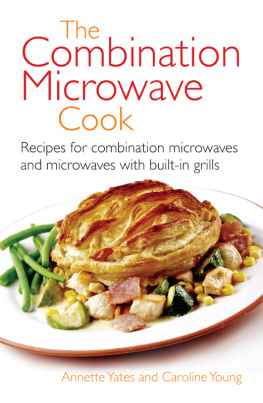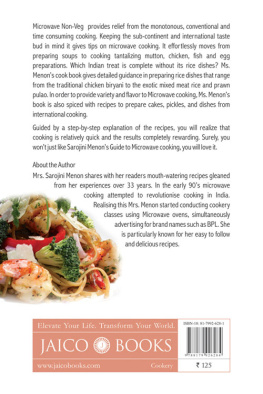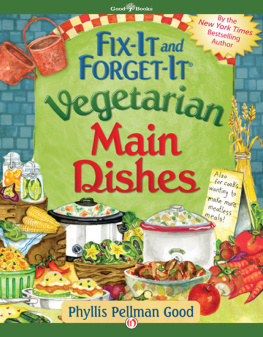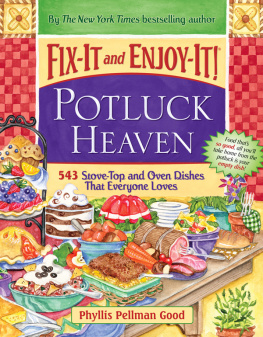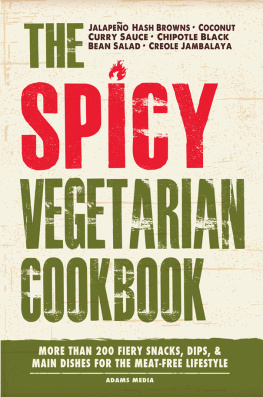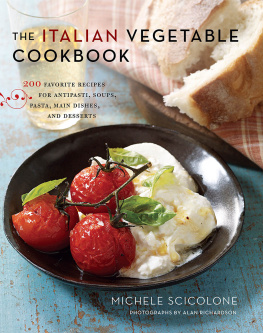THE COMBINATION
MICROWAVE COOK
In the same series
Microwave Cooking Properly Explained
Microwave Cooking Times at a Glance
Microwave Recipes for One
The Halogen Oven Cookbook
The Food Mixer Cookbook
Slow Cooking Properly Explained
Slow Cooking: Best New Recipes
www.constablerobinson.com/rightway
THE COMBINATION MICROWAVE COOK
Annette Yates & Caroline Young

Constable & Robinson Ltd
5556 Russell Square
London WC1B 4HP
www.constablerobinson.com
First published in the UK in 1997.
This new revised edition published by Right Way,
an imprint of Constable & Robinson, 2010.
Copyright Constable & Robinson 2010
All rights reserved. This book is sold subject to the condition that it shall not, by way of trade or otherwise, be lent, re-sold, hired out or otherwise circulated in any form of binding or cover other than that in which it is published and without a similar condition including this condition being imposed on the subsequent purchaser.
A copy of the British Library Cataloguing in
Publication Data is available from the British Library
ISBN: 978-0-7160-2080-6
eISBN: 978-0-7160-2347-0
Printed and bound in the EU
1 3 5 7 9 10 8 6 4 2
CONTENTS
Illustrations by Lindsay Thomas
INTRODUCTION
The arrival of the combination cooker in our kitchens means that all those irritating limitations of microwave cooking, like the lack of crisp golden-brown crusts on cakes, pies, roasts and many more dishes, are a thing of the past. Now we have the perfect answer the appliance which combines all the advantages of microwave cooking (speed, ease of use and compactness) with hot air and/or a grill to produce the crisp and browned appearance that we expect. In addition, the ability to switch from one method defrosting, microwaving, roasting, baking or grilling to another, sometimes without even having to remove the food from the oven, makes the combination cooker the most useful appliance in your kitchen.
The combination cooker will give you the result every cook aims for perfectly cooked, appetising food with the minimum of fuss and time. For todays cooks, with so many demands on their time, this must surely be the one appliance they cant afford to be without.
We are both working wives and mothers, juggling the myriad activities that we and our families are involved in, yet with a keen interest in food and in eating healthily and well. By using all the capabilities of our combination cookers, we are able to produce attractive and delicious meals in a fraction of the conventional cooking time whether we are just cooking for two or for the whole family. An added bonus is the ease with which combination cookers can be kept clean no bending or kneeling down to reach inside them!
This book explores combination cooking to the full for those of you with a combination cooker that has a fan-assisted hot air system and for those of you who use a microwave with built-in grill. For cooking with microwaves only, the companion books to this publication Microwave Cooking Properly Explained, and Microwave Cooking Times at a Glance! contain cooking techniques, recipes and time charts.
Like us, you will, in time, wonder how you ever managed without a combination cooker. First though, we do suggest that you spend a little time reading our notes on what cookware we use and how we have developed the recipes. We want you to have successful results from the very first recipe you try. Lastly, since we hate cleaning cookers as much as anyone, we also recommend that you read our suggestions on taking care of your combination cooker, with the aim of it never getting very dirty to start with!
We hope you enjoy both cooking and eating these recipes!
Annette Yates and Caroline Young
1
THE COMBINATION COOKER
WHAT IS A COMBINATION COOKER?
Knowing just what a combination cooker is, and how it works, makes it easier to use. Incidentally, we choose to use the word cooker and not oven because we feel its capabilities are far greater than those of an oven.
A combination cooker combines microwave energy with hot air, or with radiant heat from a grill, to cook and brown food simultaneously. It can, of course, be used to cook food with microwaves only. Most models can also be used to cook with hot air only (as in conventional ovens) or with grill only. Lets look at each cooking method individually.
MICROWAVE
Microwaves actually penetrate the food, attracted by its moisture, fat and sugar content. The molecules in the food agitate rapidly, causing friction, and it is the heat from this friction that cooks the food. As it is a very quick and moist form of cooking, the outer layers of the food are not browned or crisped.
Cooking by microwave only is ideal for fish, sauces, fruit and vegetables (both fresh and frozen), pasta, rice, grains and pulses, sauces, soups, steamed puddings and preserves. It is also very useful for all those fiddly jobs you would otherwise do on the hob melting chocolate or butter, blanching vegetables or liquefying ingredients like honey or jam.
Microwave energy alone is also used on the defrost program on your model.
CONVECTION
This is the traditional method of cooking food by hot air which may or may not (depending on your model) be circulated by a fan. Other models use the radiant heat from the grill element to heat the oven cavity. The compact size makes it very cost-efficient for cooking small amounts by convection only.
Small and individual food items such as biscuits, scones, rolls and small cakes should be cooked on convection only. They are so small that, if they were cooked on combination, the microwaves would overcook them before they had a chance to brown. Very rich fruit cakes are also best cooked on convection only.
GRILLING
Grills operate with the door closed and the turntable (if fitted) rotating to give even browning. They can be preheated before use.
We recommend grilling thin chops, hamburgers, bacon and gammon rashers, thin fish portions, sandwiches and things on toast such as Welsh Rarebit.
COMBINATION MICROWAVES WITH HOT AIR
This cooking method combines the use of microwaves (reducing the cooking time by around 50 per cent) with hot air (browning and crisping the surface of the food) to give dishes the traditional appearance, texture and taste that we expect. Some combination cookers use an element behind the back wall of the oven cavity to heat the air. A fan may also be fitted to circulate the air evenly. Other models use the radiant element of the built-in grill to heat the air. With some foods, the end result can be even better than with conventional cooking. Cakes will rise beautifully, with an excellent texture. Roast meats and poultry are crisp and golden brown, yet remain moist and succulent as a result of the reduced cooking time. For the same reason, meat shrinkage is also reduced.
Combination cooking is very successful for cakes and sponges, casseroles and au gratin dishes, pies and flans, desserts such as crumbles, roast vegetables, scone rounds, breads, roast meats and poultry.
MICROWAVE + GRILL
This cooking mode combines the radiant heat from the grill with microwave energy. The heat from the grill heats the air in the oven cavity as well as giving concentrated radiant heat to the top of the food. The grill operates with the door closed and the turntable (if fitted) rotates to give even browning. The grill can be preheated before use.
Next page
